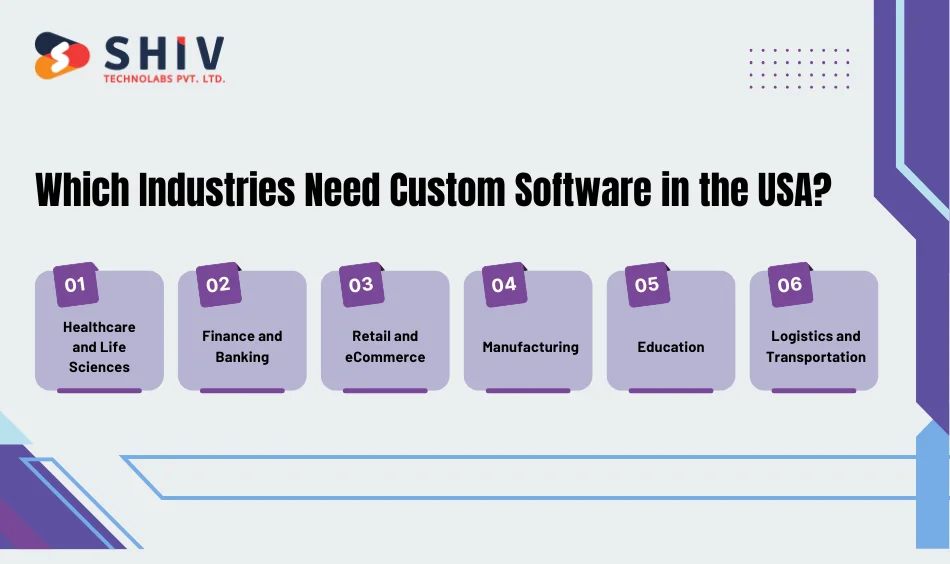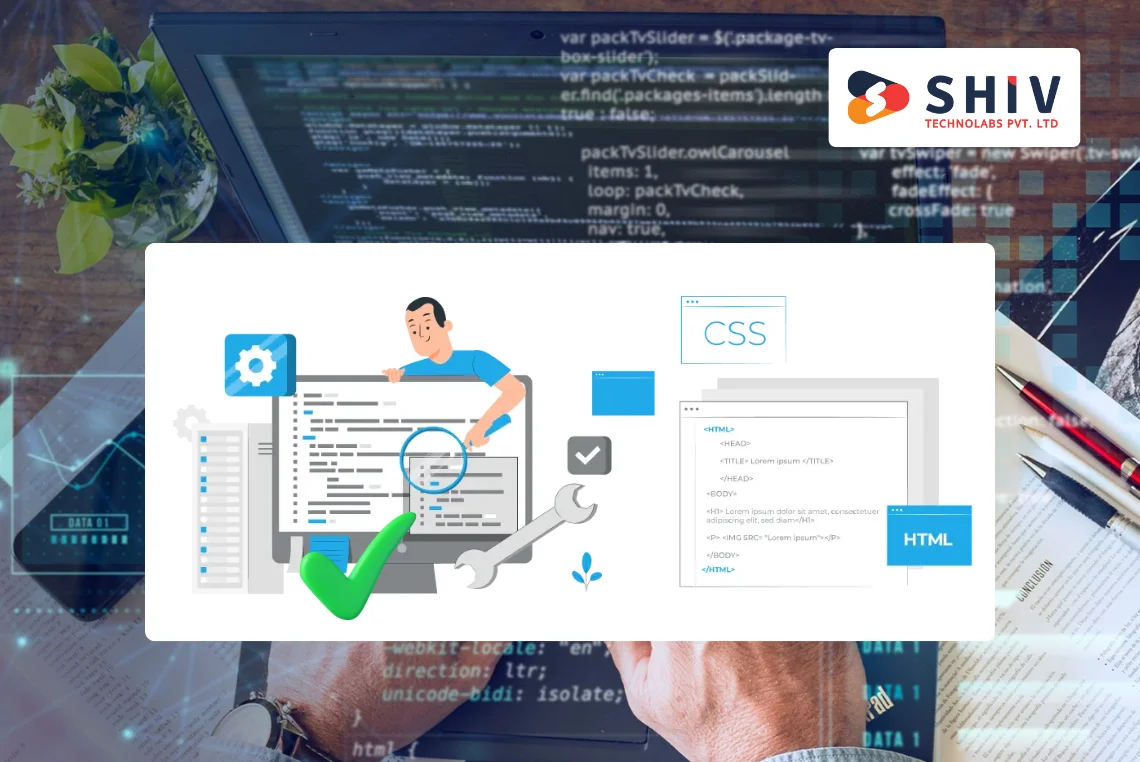Table of Contents
Software now drives how American companies sell, serve customers, and run daily operations across departments. Many leaders pick custom software development services in USA to match goals, rules, and real business workflows. They want speed, control, and reliable results without forcing rigid tools on teams or customers.
Tailored platforms cut manual steps, scale with demand, and automate routine tasks across sales, service, and finance. They reduce mistakes, shorten cycle times, and give leaders live dashboards for quicker, more confident decisions. This article shows which sectors gain first, and sets context for typical budgets by scope and timeline.
The sections that follow map sector priorities, common pitfalls, and budget ranges by project complexity. You will see practical examples, decision points, and planning tips that reduce risk from day one. Use this guidance to plan a focused start, measure impact, and grow features with real demand.
Which Industries Need Custom Software in the USA?

Leaders often ask which industries need custom software in USA and where results arrive fastest. The leading industries using custom software in USA include healthcare, finance, retail, manufacturing, education, and logistics. Each sector shows clear gains in speed, accuracy, security, and customer experience with the right roadmap.
Healthcare and Life Sciences
Providers need connected systems that simplify intake, scheduling, billing, and reporting across clinics, labs, and pharmacies. Telehealth, EHR, and patient portals share accurate data with approved staff under HIPAA rules and consent flows. Teams move faster, reduce paperwork errors, and give patients clearer communication at every touchpoint daily.
Custom builds align coding, billing checks, and payor requirements, which speeds reimbursements and strengthens audit readiness. They also support role-based access, incident tracing, and secure data exchange between partners and devices.
Key solutions:
- Electronic Health Records (EHR)
- Remote patient monitoring systems
- Pharmacy and lab management solutions
Finance and Banking
Banks and fintech teams depend on secure platforms for payments, lending, trading, and audits at national scale. Risk engines, mobile banking, and AI fraud checks protect revenue and support tough reporting deadlines. Data pipelines connect KYC tools, credit systems, and partner APIs without fragile workarounds during spikes.
Snapshots that show speed to value:
- Healthcare clinic: Unified intake and billing cut claim errors 28% in 90 days. Reimbursement cycle dropped by six days.
- D2C retailer: Inventory and POS sync cut stockouts 31% during holiday peaks. Return rate fell 12%.
What does a 4-week discovery include?
- User stories for core roles
- Interface sketches and click-paths
- Integration map with live API checks
- Risk list with owners and next steps
Retail and eCommerce
Retailers link Shopify or WooCommerce with POS, fulfillment, and loyalty programs for consistent shopping across channels. Real-time stock, targeted offers, and customer analytics guide merchandising and prevent lost sales on peak days. Clear product data and predictable fulfillment reduce returns, improve satisfaction, and protect margins during busy seasons.
Custom store apps support fast launches, bold promotions, and simple returns across states and marketplaces. Teams test new flows, measure results quickly, and repeat winners, which lifts conversion and lifetime value.
Key tools:
- eCommerce automation
- Customer engagement tools
- Payment gateway integration
Manufacturing
Manufacturers adopt ERP, CRM, and warehouse systems to connect orders, materials, and production lines with clear visibility. Real-time tracking spots bottlenecks early, while automated checks catch defects and protect margins during busy periods.
Custom apps read machine signals, schedule maintenance, and alert teams before small issues stop a shift. Leaders view capacity, yield, and scrap in one place, then act quickly with clear targets and timelines.
Common wins for top sectors using custom business software:
- Real-time production tracking and work-in-progress visibility
- Automated quality checks tied to tolerance rules and audits
- Connected procurement, inventory, and shipping for faster order cycles
Education
Schools and training providers need platforms for digital courses, assessments, and student records on a growing scale. Custom portals sync grades, attendance, and payments with district systems and trusted education vendors.
AI grading saves instructor time and focuses effort on clear, helpful feedback that students can act on. Analytics flags learners needing help sooner, while role-based access supports FERPA rules and audits.
Key solutions for modern campuses:
- Learning management systems with single sign-on and mobile access
- Assessment engines with automated scoring and remote proctoring options
- Student data dashboards for progress, retention, and funding reports
Logistics and Transportation
Carriers and shippers depend on dispatch boards, fleet health tools, and driver apps to cut wasted miles. Smart route planning reduces fuel spend, while geofencing and ETA alerts keep customers informed end-to-end.
Predictive maintenance lowers roadside incidents and protects capacity for priority lanes during tight schedules. Integrated billing and claims tools speed settlements and reduce revenue leakage across long, multi-stop moves.
Operational gains that show up quickly:
- Fleet health monitoring with fault codes and service queues
- Load, lane, and carrier scorecards for quicker tender decisions
- Real-time visibility for shippers, brokers, and receivers
Why Do USA Companies Prefer Custom Software Over Off-the-Shelf Solutions?
Companies often ask why USA companies prefer custom software when standard tools seem cheaper at first glance. The reasons are control, scale, security, and a close fit with real workflows that drive revenue.
Full control and scalability
Product owners pick features that matter now and add modules when demand grows or rules change. Teams grow users, data, and capacity without waiting on a vendor roadmap or buying unused bundles.
Key differences
- Scalability: Custom adapts as you grow; off-the-shelf stays limited to preset tiers.
- Cost over time: Custom builds return more value; off-the-shelf adds upgrade and add-on fees.
- Security: Custom matches industry rules and policies; off-the-shelf carries shared exposure.
- Integration: Custom fits your tools and data; off-the-shelf often needs workarounds.
Competitive advantage
Proprietary features reflect your offer and sales motion better than generic tools built for everyone. Teams ship faster, cut handoffs, and protect margins during seasonal peaks and market shifts.
Data security and compliance
Regulated sectors face strict rules and frequent audits across many systems, users, and records. Tailored controls, logging, and retention policies reduce exposure and speed evidence gathering during reviews.
Benefits of Custom Software for USA Businesses
Leaders care about results they can measure and repeat across teams. The key benefits of custom software for USA businesses center on faster work, stronger data control, and better customer outcomes. You gain systems that match real processes, rather than forcing processes to match generic tools.
Improved Efficiency and Automation
Teams replace manual steps with guided workflows that cut errors and shorten cycle times across operations, sales, and service. Role-based screens show only what each person needs, which reduces confusion and speeds task completion during busy hours.
Automation rules push work to the right queue, send alerts when thresholds break, and prevent duplicate entries. Integrated approvals move faster, while audit trails keep records clean for reviews, rebates, and vendor programs that matter.
Better Customer Experience
Personalized apps, CRM links, and accurate product data help staff answer questions quickly and with confidence. Customers see consistent status across web, mobile, chat, and store, which reduces frustration and repeat contacts.
Loyalty logic rewards the right actions at the right time and lifts lifetime value without spammy outreach. Clear returns, reliable promises, and fast refunds build trust and encourage second purchases in tough markets.
Integration with Emerging Technologies
Modern builds connect with AI, blockchain, and IoT without bolted-on workarounds that break under load. You can run smarter forecasting, secure transactions, and real-time equipment checks inside one source of truth.
Top tech integrations driving software success in the USA:
- AI-powered analytics
- Blockchain for secure transactions
- IoT sensors for smart operations
These integrations raise visibility, support cleaner decisions, and keep systems responsive when demand spikes or rules change. Product teams ship targeted upgrades more often, while leaders see trends early and act with clarity.
Cost Efficiency and ROI
Custom software may start with a higher project budget than basic subscriptions, yet long-term math often wins. You cut recurring license waste, avoid pricey add-ons you never use, and retire shadow spreadsheets that hide risk.
Smart teams define a baseline, ship a focused pilot, and track time saved, error rates, and conversion gains. When numbers move, they expand features that pay back quickly and delay ideas that do not help. That rhythm keeps costs honest and returns steady across quarters.
Industry-Wise Custom Software Pricing in the USA

Buyers often ask how much custom software costs in the USA before scoping real work. Prices shift with features, integrations, security goals, data work, performance targets, and chosen team mix. Use this industry-wise custom software pricing USA snapshot to anchor planning and early vendor discussions.
Factors that move the price
Set the big levers early, and your team avoids costly surprises later in delivery and testing. Clear choices keep work focused, schedules predictable, and budgets stable across sprints and releases alike.
- Define scope and complexity: screens, roles, workflows, edge cases, and reporting depth.
- Confirm integrations: ERPs, EHRs, payment rails, KYC, tax, shipping, or carrier APIs.
- Plan data work: cleaning, mapping, migration, and retention rules with owners named.
- Meet security needs: HIPAA, SOC 2, PCI, or FERPA controls, logging, and audits.
- Pick a team model: onshore, nearshore, offshore, or a blended approach.
- Set performance goals: concurrency targets, response times, uptime, and mobile support.
- Include post-launch care: monitoring, fixes, and minor upgrades in year one.
Estimated custom software cost by industry (USA)
| Industry | Typical range (USD) | Example applications |
|---|---|---|
| Healthcare | 80,000–250,000 | EHR, telehealth, patient portals |
| Finance | 100,000–300,000 | Trading tools, risk, compliance |
| Retail/eCommerce | 60,000–200,000 | CRM, inventory, checkout, POS links |
| Manufacturing | 70,000–220,000 | ERP, MES, warehouse systems |
| Education | 50,000–180,000 | Learning portals, admin dashboards |
| Logistics | 90,000–240,000 | Fleet, routing, tracking, billing |
Treat these figures as directional, not commitments; complexity and compliance can raise or lower totals. A short discovery that produces user stories, interface sketches, and a risk list will narrow the spread.
How to estimate your budget
Start with three outcomes you can measure, such as fewer manual hours, faster order cycles, or higher conversion. Map the smallest set of features that move those numbers, and place everything else in a later phase. Pick a stack your team can support after launch, and confirm every integration with live API references.
Ask for two paths from vendors: a tight MVP and a broader release with more modules and roles. Compare both against time saved, errors removed, and new revenue within the first six months. Keep a 10–15% buffer for data cleanup and findings that appear during testing, especially around payments and identity.
Modern Software Solutions Transforming American Businesses
Teams across the United States run daily work on AI, cloud, and data platforms. These modern software solutions for American businesses improve reliability, speed decisions, and cut manual steps that slow growth.
How does AI help US companies today?
AI forecasts demand, flags fraud, and suggests next actions for sales and support teams. Chatbots answer routine questions fast, while agents handle complex issues with full context.
Why choose cloud platforms?
AWS, Azure, and Google Cloud scale traffic, storage, and analytics without heavy hardware plans. Engineers release updates faster and lower outage risk with backups, autoscaling, and managed services.
Where does blockchain add value?
Shared ledgers bring traceability to banking, trade finance, and supply chains. Smart contracts remove manual approvals in settlements and vendor agreements across partners and regions.
How do data dashboards speed decisions?
Dashboards combine orders, tickets, and finance data into one view that leaders can trust. Self-serve reports cut wait times for insights and raise accountability across teams.
How to Choose the Right Custom Software Development Partner in the USA
Pick a partner that knows your market and delivers on time with proof you can verify. Mention custom software development services in USA early so proposals match local rules and hosting needs.
Do they have experience in my industry?
Ask for case studies that match your volumes, channels, and regulations. Confirm the same senior people who built those wins will staff your project.
Do they use modern engineering practices?
Look for current frameworks, CI/CD, code reviews, and automated tests across layers. Confirm release cadence, rollbacks, and observability so changes reach production safely.
Will they support the product after launch?
Request response times, patch policies, and uptime targets with named contacts. Ask how they handle upgrades, performance tuning, and incident reviews.
Are cost and communication clear?
Seek milestones with deliverables, acceptance criteria, and payment terms. Hold weekly demos and assign a single owner who removes blockers quickly.
Why Shiv Technolabs for custom software development services
Need reliable custom software development services in USA for healthcare, fintech, retail, or manufacturing? Our specialists plan, build, and support secure, high-performance software on a clear schedule. We align features to measurable outcomes you can track from the first release.
Conclusion
Every major sector now invests in tailored platforms that cut errors and build customer trust. With tight scopes and steady releases, teams see gains in weeks and compound results over quarters. Partner with a trusted Custom Software Development Company in USA to build solutions matched to your business goals.
FAQs
Which industries invest most in custom software in the USA?
Healthcare, finance, eCommerce, manufacturing, education, and logistics lead current spending and active projects.
What benefits stand out for American businesses?
Faster work, fewer mistakes, stronger security, and better customer experiences across web, mobile, and store.
How much does custom software cost in the USA?
Typical builds range from $50,000 to $300,000, depending on features, integrations, and compliance depth.
Why pick custom over ready-made tools?
You gain control, scale, and a tight fit with real workflows and data.
How can I find reliable developers in the USA?
Check relevant case studies, call references, review release practices, and confirm written support terms.






















